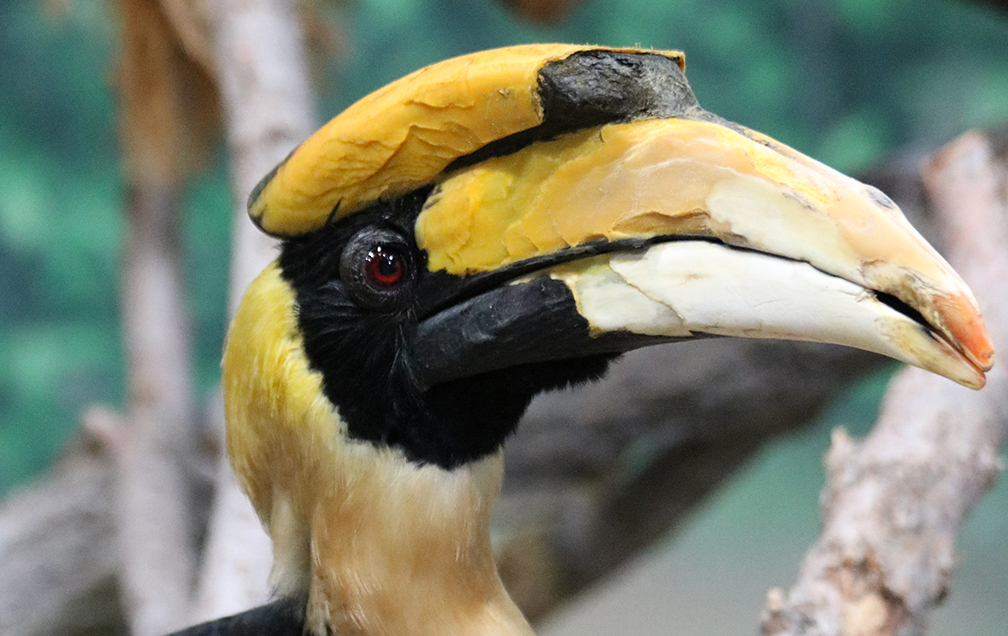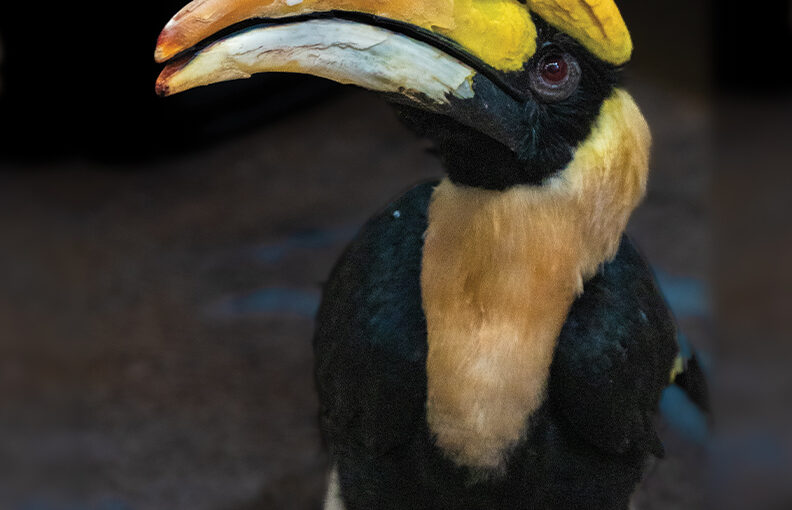The most conspicuous feature of the great hornbill is its casque, a hollow structure located on top of the massive bill. When viewed from the front the casque is U-shaped, with two ridges along the sides that form points in the front and give the species its Latin name bicornis, meaning two-horned.
Classification
| CLASS: | Aves |
| ORDER: | Coraciiforme |
| FAMILY: | Bucerotidae |
| GENUS: | Buceros |
| SPECIES: | bicornis |
Habitat & Range
Great hornbills reside in wet evergreen and deciduous old growth forests at elevations of 600 to 2000 meters (1968.5 to 6561 feet). For nesting, they prefer trees that tower above the canopy level.
The great hornbill is found in forests in mainland Southeast Asia, including Bhutan, Nepal, southwest China, southwest and Himalayan India, Cambodia, Laos, Myanmar, Thailand , Vietnam . Some populations still exist on the Malay Peninsula and the island of Sumatra.
Location


Adaptations
- The species’ most striking adaptation is the hollow casque, but its function is not precisely known. It may serve to attract females, to dominate other males, or to serve as a resonance chamber that amplifies the sounds the birds make. The size and color are also an indication of the age of the bird.
- The first two cervical (neck) vertebrae are fused to help support the birds’ large bills.
- The sealing of the nest by the female is thought to have evolved as a predator deterrent. It may also ensure the male’s fidelity to the nest, female and young.
- Great hornbills are highly vocal. Pairs use duets as part of courtship, and the birds call loudly and frequently within their large, communal night roosts.
- This species never needs to drink but obtains the water it needs from its diet.
Physical Description
- The great hornbill is one of the largest hornbills, weighing on average 3 kg (6.6 pounds) and ranging in length from 95 to 120 cm (37.4 to 47.24 in.) with a wingspan of 151 to 178 cm (59 to 70 inches).
- They are vividly colored. The body, head and wings are mostly black; the abdomen and neck are white. The tail is white with a black band. A preen gland near the tail secretes tinted oil, spread by the bird during grooming, which may give the bill, neck, tail and wing feathers a color varying from yellow to red.
- The most conspicuous feature of the great hornbill is its casque, a hollow structure located on top of the massive bill. When viewed from the front the casque is U-shaped, with two ridges along the sides that form points in the front and give the species its Latin name bicornis, meaning two-horned.
- Males and females have identical plumages, but the female is smaller and has a bluish-white iris, while the male’s is red. The back of the casque is reddish in females and the underside of the front and back of the casque is black in males.
- They lack the short feathers under the wing (underwing coverts) that cover the bases of the primary and secondary flight feathers in other birds. As a result, their flight is often noisy and produces a characteristic “whooshing” sound.
- Like many other hornbills, great hornbills have prominent eyelashes on their upper eyelids.
Diet
What Does It Eat?
In the wild:
Great hornbills primarily (70%) eat fat-rich and sugar-rich fruits, but they also feed on small mammals, birds, eggs, amphibians, reptiles and insects. Figs are a particularly important food throughout the year. This species has been known to protect fig trees from other birds.
At the zoo:
They eat iron-rich fruits, bird pellets and super worms.
What Eats It?
Man is the chief predator of great hornbills. Tribal members hunt them for their beaks and head to use in charms. The flesh is believed to be medicinal by some. They are also hunted for their fat, which is highly prized and is used for a variety of purposes, from medical treatment to gun polish, and for their casques, meat and feathers, which are used in various rituals.

Social Organization
Great hornbills form monogamous, territorial pairs but may also be seen in small family groups or flocks of up to 40 birds. Group courtship displays involving up to 20 birds have been observed. Groups of birds will sometimes gather together at fruit trees. At night they gather in large communal roosts which may contain hundreds of individuals. At these roosts the birds are highly vocal, making sounds that can be described as “cackling” or “roaring.” The roosts may function as information hubs, where individual birds share information regarding feeding sites, for example. Pairs generally mate for life
Life Cycle
Great hornbills breed from January/February to May/June. Prior to the breeding season males fight each other by butting their casques, often in flight, possibly in competition for females. A pair will perform duets as part of courtship, wherein a male and female alternate calls to each other. They select a nest cavity in a large tree. When the female is ready to lay her eggs, she seals herself into the nest cavity using feces, food debris, and wood to cover the entrance from the inside. She leaves a small slit through which the male feeds her while she lays one or two eggs and incubates them for 38-40 days. During this time the female completes a full molt. Although she typically lays 2 eggs, usually only one chick hatches. When the chick is about 5 weeks old the female emerges from the nest and helps the male feed it. The chick re-plasters the nest entrance and is fed through the slit for another two weeks. After the chick emerges, the parents continue to feed it until it is about 15 weeks old, when it becomes independent. The young birds do not have a casque initially but start to grow one at about 6 months of age. Full development of the casque takes 5 years. The size of the casque may be important in female selection of a mate. Great hornbills can live 50 years under human care but average 35-40 years in the wild.















